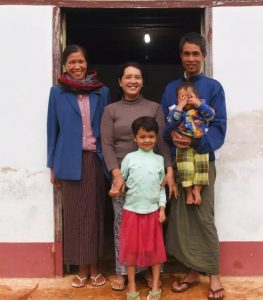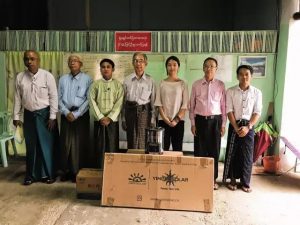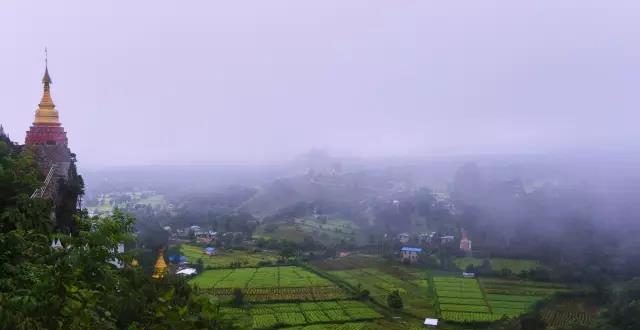GEI Insight | Community Conservation in Myanmar
As one of the countries boasting a great variety of animals and plants, Myanmar is home to 15 biodiversity conservation corridors and over 130 biodiversity hot spots. There live tigers, Asian elephants, Myanmar snub-nosed monkeys and rare plants, such as rosewoods and teak woods.
 Photo Credit: GEI
Photo Credit: GEI
However, despite this biodiversity abundance, this country is ranked second on the list of countries for being most vulnerable to climate change and third for the most severe deforestation. The land, beautiful but fragile, needs your attention and help from the world.
To protect the precious natural resources of Myanmar, GEI’s Ecosystem Conservation and Community Development team helped develop and adapt a conservation agreement for 16 communities surrounding four reserves.
It was the first time a Chinese NGO has ever launched a community project overseas.
This time, GEI visited ten of the 16 communities and investigated the community conservation work the Myanmar NGO and local communities did.
Community Conservation in Myanmar
It was June and just amid the rainy season in Myanmar. Rain would come intermittently every two hours, afterward leaving the air feeling fresh and clean and the plants with a dewy finish. This marked the beginning of our journey in Myanmar.
For this trip, our aim was to check on the progress of the community project. Along with our friends from Myanmar NGOs, we would cross the country all the way to the south, hearing from locals’ stories about environmental protection in Burmese communities.

Community Leader and family. Photo Credit – GEI
We hoped to communicate with the locals, to help them better understand our project, and further extend the innovative and effective protection mechanism to other regions.
Myanmar’s communities have, in fact, long been involved in environment protection efforts. The forestry department started to promote a community forest project as early as 1995, and worked out a 30-year reforestation plan to ensure that 2.27 million acres of forests by 2031 under the supervision of forestry groups.
Protecting Endangered Species
When talking with the locals, we were surprised to find that some wild species, which as outsiders, we consider rare and precious, were otherwise spoken about like old friends they meet everyday.
“I spotted traces of tigers when I was doing farm work, and came across leopard cats, monkeys, pangolins , and even five peacocks once,” said one of our interviewees.
Among those animals, tigers, pangolins and snub-nosed monkeys are on the IUCN Red List of Threatened Species, and the peacocks he saw, were not ordinary ones, but green peafowls – the national bird of Myanmar.
Green peafowl has become a major symbol of Myanmar since the Kongbaung Dynasty. It now holds a major part on the flag of the National League for Democracy, the ruling party of Myanmar led by Aung San Suu Kyi that as a result, is nicknamed the “peacock party.”
However, due to damages to their habitats and illegal hunting, green peafowls are now on the verge of extinction, with the number of wild peafowls reduced to about 2,000 in Myanmar.
Fortunately, communities we visited have already realized the importance of conservation of animals and plants. They would regularly patrol and monitor the habitats to prevent poaching.
CCCA in Myanmar
GEI and Myanmar NGOs introduced a community forestry agreement whose regulation is more scientifically based and incorporates community development approaches. Communities would be supported to develop different forms of income, without posing harm to the environment.

GEI Staff and Officials in Myanmar
In Ya Gyi Village, west of Shan State, the villagers built ten acres of bamboo gardens and five acres of coffee garden reserves. The profits belonged to the community as a whole, which would be used to build hospitals and schools.
Moreover, small loan funds were established so that some impoverished families could apply to raise piglets for a living. The money was paid back one year later, including the principal and the accrual that would be partly used for community environmental protection, while the rest returned to the fund to help other families.
The In-Kind Aid for Climate Change
The community project jointly developed by Chinese and Myanmar NGOs have won great support from governments. In 2017, China donated 10,000 clean stoves and 5,000 household solar lights to Myanmar through the South-South Climate Change Fund. 300 stoves and 300 solar systems were given away through our project to pilot communities.

Photo Credit: GEI
To ensure the sustainability of the donation, we proposed a discussion among NGOs and the communities, and decided to sell part of the donation to families at a price much lower than the market price. The proceeds of the sale would return to the community fund for family loans.
With the continued vision and implementation of South-South cooperation and our project, we expect a long-lasting impact of climate aid on the environment and the society of Myanmar. In doing so, we hope that Myanmar can serve as a model for other Global South countries to adopt for sustainable development.

